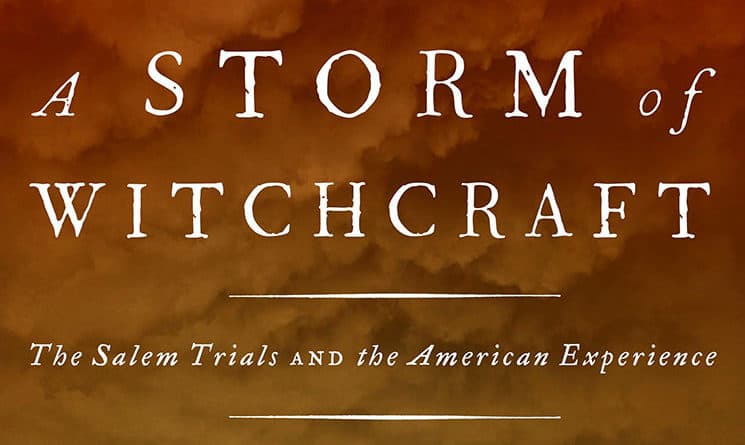The Salem Witch Trials engulfed Salem, Mass., and surrounding areas for a little more than a year. Twenty people, most of them women, were executed. Some 300 years later, our collective cultural image of witches and Salem is that of an old crone wearing a pointy hat and flying on a broom, silhouetted against a full moon.
But the reality of the trials, and their legacy, is far more complicated than a pop-culture caricature or the yearly festivals that now overtake Salem would suggest. In his latest book, “A Storm of Witchcraft: The Salem Trials and the American Experience,” out now from Oxford University Press, York author and historian Emerson “Tad” Baker offers an account of the context behind the witch trials and looks at how a brief, tragic moment in New England’s history still reverberates today.
The first misconception about the trials is that they were limited to Salem. That’s not the case, Baker said. Accusations of witchcraft swept through colonial New England in cities and towns like Portland and York, Maine, years before they came to Salem.
“Unfortunately, Salem gets so much attention that few people realize that there are a number of cases of witchcraft in New England well before Salem, such as (Hampton’s) Eunice Cole,” said Baker.
A professor at Salem State University, Baker has been studying accusations of witchcraft in colonial New England for 20 years. His previous book, “The Devil of Great Island,” chronicles a witchcraft case in New Castle that preceded the events in Salem by a decade.
Though lurid tales of deals with the devil, dramatic accusations, and public executions helped sear the trials into our collective imagination, for Baker, it is the political and social contexts of the witch trials that are more interesting.
At the time of the trials, Maine was a part of the Massachusetts Bay Colony, which was in the midst of a four-year conflict between English settlers and Native Americans known as King William’s War. The settlers ventured north from Massachusetts, hoping to establish additional colonies.
“Almost all the settlements in Maine had been destroyed by the enemy, many of them in bloody raids. Hundreds of people had lost their lives, and others became refugees,” said Baker. “Refugees came home to Salem and Essex County with little more than the clothes on their backs.”
As Baker examined these events closely, he learned that refugees returned mentally devastated by the events of the war. Many exhibited what would be recognized today as symptoms of post-traumatic stress disorder. For this reason, Baker said, some of the refugees began acting out, and their actions were blamed on dealings with Satan and experiments with dark magic.
“For Puritans, it really did seem like Satan was loose, and set on destroying New England.” — author Emerson Baker
Baker said the near destruction of the settlement in York in January1692 may have had a direct correlation to the hysteria in Salem, as Puritans believed Satan was literally challenging their lives.
“Everything back then was a sign of God’s pleasure and displeasure. And for Puritans, who believed they had a special compact with God, to be losing this war to Native Americans, who they saw as heathens, and French Catholics, at the time (when the) English had a pathological hatred and fear of Catholics and the Pope, it really did seem like Satan was loose, and set on destroying New England,” said Baker. “It was time to root out the witches who were his minions and to save the colony.”
As Baker details in the book, the accusations of witchcraft in New England, and the events that led to the chaos in Salem stemmed from varying circumstances. Land disputes, war, religious affiliations, and gender attitudes all influenced how or why someone might be accused.
The trial’s targets tended to be “older women, usually poor, and often widowed,” said Baker, who estimates nearly 75 percent of the accused were women. Some were singled out because of contentious personalities; others kept to themselves, which curated an air of mystery about them; some weren’t regular churchgoers. Whatever the reason, the end result was an accusation, a trial, and, for many, execution.
Today, Baker says Salem has become a place where tourists leer back at our ancestor’s penchant for executions while gleefully buying souvenirs. It is something Baker says he, and the city, have wrestled with.
“Over a million tourists come to Salem every October for Haunted Happenings, which combines the witch trials into a series of festive Halloween events. However, many of us are deeply disturbed by this,” said Baker. “I have no problem with scary costumes, parades, and eating fried dough. But is this really the appropriate way to mark the tragic and wrongful deaths of innocent and devout Christians?”
Walk the streets of Salem today and you’ll see how the city has turned this blemish into a boon. You’ll also find a city accepting of a diversity of cultures and religions. It’s a far cry from the panic of the witch trials. But, though Salem has changed, it still carries the scars of that tempestuous year.
Emerson Baker will discuss “A Storm of Witchcraft” on Wednesday, Jan. 21 at 6 p.m. at Rice Public Library, 8 Wentworth St., Kittery, Maine. Call 207-439-1553.
Author Emerson Tad Baker (courtesy photo)

